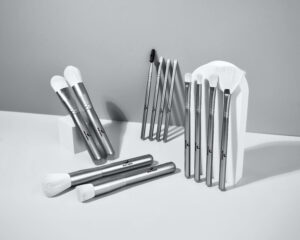Hygienic Habits

In the world of beauty, achieving flawless looks is an art form, and the tools we use are the brushes and palettes of our creativity. However, beyond mastering techniques and investing in high-quality products, maintaining clean beauty tools is an essential aspect of a healthy and radiant complexion. In this beauty blog, we embark on a journey into the realm of hygienic habits, exploring the best practices for keeping our beauty tools pristine, ensuring not only stunning results but also safeguarding the health of our skin.
The Importance of Clean Beauty Tools
- Preventing Skin Issues:Beauty tools, from brushes to sponges, come into direct contact with our skin. Failure to keep these tools clean can lead to the accumulation of bacteria, oils, and makeup residue, potentially causing skin irritation, breakouts, or even infections. Clean tools are paramount in maintaining the health of our skin, preventing unwanted skin issues that may arise from bacterial contamination.
- Preserving Product Performance:Clean beauty tools also contribute to the optimal performance of the products we invest in. Accumulated product residue on brushes and sponges can alter the texture and color of makeup, affecting the intended outcome. Regular cleaning ensures that your tools perform as intended, allowing you to achieve the true potential of your makeup products.
Best Practices for Clean Beauty Tools
- Regular Cleaning Routine:Establishing a regular cleaning routine for your beauty tools is fundamental. Brushes, sponges, and other applicators should be cleaned after each use or, at the very least, once a week. This prevents the build-up of bacteria and ensures that your tools remain in top condition.
- Use Gentle Cleansers:When cleaning your beauty tools, opt for gentle cleansers that effectively remove product residue and bacteria without compromising the integrity of the tools. Mild soaps, baby shampoo, or specialized brush cleansers are excellent choices.
- Invest in Quality Tools:High-quality beauty tools made from durable and non-porous materials are easier to clean and less prone to harboring bacteria. Consider investing in tools with synthetic bristles, as they are less likely to trap bacteria compared to natural hair bristles.
- Regularly Replace Beauty Sponges:Beauty sponges, such as makeup blenders, are porous and can harbor bacteria more easily. Regularly replace your beauty sponges every few months to ensure a clean application. Alternatively, clean them thoroughly after each use.
- Dry Properly:After cleaning, ensure that your beauty tools are thoroughly dried before the next use. Moist environments are breeding grounds for bacteria, so allowing your tools to air-dry completely is crucial. Consider investing in drying racks or stands to promote proper air circulation.
- Be Mindful of Cross-Contamination:Avoid cross-contamination by using separate tools for different products. For example, have dedicated brushes for powder products, creams, and liquids. This prevents color transfer and reduces the risk of introducing bacteria from one product to another.
- Store Tools Properly:Proper storage is essential for maintaining the cleanliness of your beauty tools. Use brush holders or containers to keep brushes upright and prevent them from touching surfaces that may harbor bacteria. Beauty sponges should be stored in well-ventilated containers to promote air circulation.
- Deep Clean Periodically:In addition to regular cleaning, perform deep cleaning sessions for your beauty tools. This involves more thorough cleansing to remove deep-seated residue and bacteria. Deep cleaning can be done with a mixture of water and gentle soap or a specialized cleaning solution.
- Disinfect Regularly:Consider incorporating a disinfecting step into your cleaning routine, especially for tools that come in direct contact with your skin. Disinfectant sprays or solutions can be used on brushes, tweezers, and other tools to kill bacteria and prevent contamination.
- Practice Makeup-Free Days:Give your skin a break by incorporating makeup-free days into your routine. This allows your skin and beauty tools to breathe and recover, reducing the likelihood of clogged pores and bacterial build-up.
Product Recommendations for Effective Cleaning
- BeautyBlender Blendercleanser Solid:A solid cleanser specifically designed for beauty sponges and brushes, the BeautyBlender Blendercleanser Solid effectively removes makeup residue and bacteria, ensuring a thorough clean.
- Cinema Secrets Professional Brush Cleaner:This professional-grade brush cleaner is quick-drying and effective, making it a favorite among makeup artists. It cleans, conditions, and disinfects brushes, leaving them ready for immediate use.
- Japonesque Solid Brush Cleanser:The Japonesque Solid Brush Cleanser is a gentle and conditioning formula that effectively removes build-up from brushes. Its compact design makes it convenient for travel and on-the-go cleaning.
- Parian Spirit Professional Brush Cleaner:Known for its fast-drying formula, the Parian Spirit Professional Brush Cleaner is a versatile option for quick cleaning between makeup applications. It effectively removes product residue and disinfects brushes.

Maintaining clean beauty tools is a crucial step in achieving a flawless makeup application while prioritizing the health of your skin. By adopting these hygienic habits and integrating effective cleaning products into your routine, you not only enhance the longevity and performance of your beauty tools but also ensure that your skin remains vibrant and free from potential irritants. Embrace the art of clean beauty tools, and let your radiant complexion shine through every brushstroke.

